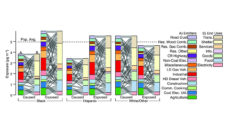The grid of interstates and highways crisscrossing the United States and the fleets of freight-transporting diesel trucks on these roads guarantee we can get anything we want, anywhere we want it. But all these engines spill exhaust that pollutes our air, increasing chances of illnesses like asthma, emphysema, chronic obstructive pulmonary disease, and cancer. Our demand for freight is projected to double by 2050, the threat to our health will rise alongside.
Diesel engines are harmful because they release particulate matter (PM2.5) and nitrogen oxides into the atmosphere as they combust. Because of Environmental Protection Agency (EPA) regulations imposed in 2010 and technology improvements over the last 30 years, diesel engines now release 98% less PM2.5 into the atmosphere compared to engines built in 1990. Even after these changes, the diesel freight sector is the largest emission producer of PM2.5 in the United States.
A team of researchers led by Shuai Pan developed a predictive model to track the effectiveness of various diesel regulations at saving money and preventing premature death. Using current standards as a control, they compared two scenarios: stricter climate policies like carbon taxes and completely removing all super-emitters—diesel engines releasing the greatest amount of pollutants—from highways. Their model projected changes in mortality, air pollution, and money saved in each regulation scenario.
The figure shows that implementing stricter climate policies will lead to 300 fewer deaths per year than the current standards. Completely eliminating super-emitters would decrease annual deaths by an additional 500.
Since 2017, the EPA has rolled back nearly 100 environmental protections. These findings suggest that we need to be doing the exact opposite: strengthening environmental protections to improve public health.
Databyte via Pan, S., Roy, A., Choi, Y., Sun, S., & Gao, H. O. (2019). The air quality and health impacts of projected long-haul truck and rail freight transportation in the United States in 2050. Environment International, 130, 104922.














